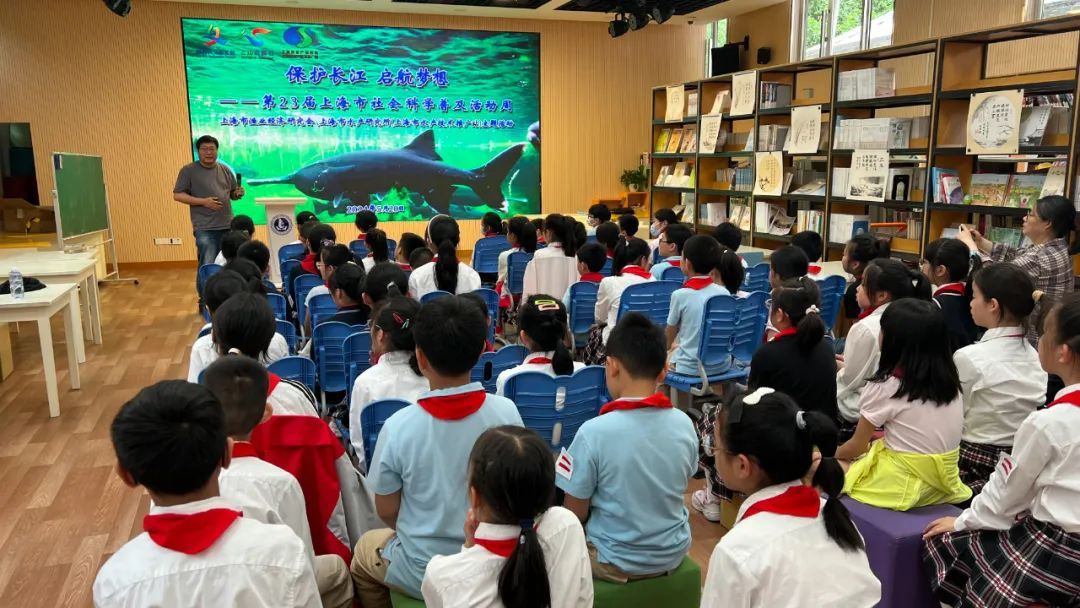Educating Through Entertainment: Primary School Students Embark on an Aquaculture City Walk May 22,2024
Stepping into college campuses to attend thought salons, arranging a cultural city walk with friends, visiting popular social science venues in groups, and enjoying social science markets with children...
Recently, the 23rd Shanghai Social Science Popularization Activity Week is underway throughout the city. On May 20th, the Shanghai Aquatic Research Institute, in conjunction with the Shanghai Fishery Economic Research Association, held a "Protect the Yangtze River, Embark on Dreams" science popularization event at the Changbai Second Village Primary School and the headquarters of the Shanghai Aquatic Research Institute. This marked the beginning of a city walk focused on aquaculture.
"See this long fish specimen I'm holding? Its name is eel. Do you students know whether eels live in the Yangtze River or in the ocean?" At the Changbai Second Village Primary School's science event, Dr. An Chuanguang from the Shanghai Aquatic Research Institute, holding meticulously prepared fish specimens, introduced each specimen to the students, explaining their names, species, and conservation status.

"Eels are a type of migratory fish. Normally, they reside in large freshwater rivers like the Yangtze and Pearl Rivers. However, when they are ready to spawn and raise their offspring, they swim from these freshwater rivers to the ocean to lay their eggs and hatch their progeny. The hatched eel larvae then migrate back to the freshwater rivers along the route their parents took. This lifecycle of migration is how eels spend their lives."
After Dr. An Chuanguang's explanation, the students gained a deeper understanding of eels. Gao Ziyu, a fourth-grade student at Changbai Second Village Primary School, said, "I had heard of eels before but didn't know their lives were so fraught with hardship, migrating back and forth between the sea and the rivers, facing many unknown dangers along the way. It's truly not easy for them to survive. We students must cherish the Yangtze River environment and the ocean environment, offering them the warmest protection during their life processes, so they can grow up healthy."
As protected species in the Yangtze River, Japanese eels (Anguilla japonica) primarily grow naturally, and artificial breeding remains a significant challenge. Dr. An Chuanguang noted that the specifics of the initial feed for eel larvae are still not fully understood, nor can the environmental conditions for their growth and development, such as temperature and salinity, be precisely controlled. Therefore, the propagation and growth of river eels in China still rely entirely on natural reproduction. Humans must provide ample care and protection for eels to ensure their healthy development.
Besides protecting fish in the Yangtze River, understanding the broader "Protection of the Yangtze River" is also essential theoretical knowledge for students. Qiu Chuwen, a senior engineer at the Shanghai Aquatic Research Institute, delivered a popular science lesson titled "Major Protection of the Yangtze River" using witty, straightforward language. This lesson helped students learn about the Yangtze River basin, its culture, the special fisheries resources in the river, and the importance and measures of protecting the Yangtze ecosystem.
What new techniques will students discover in the aquaculture laboratories? At the Shanghai Aquatic Research Institute's fish breeding laboratory, water quality detection laboratory, aquaculture product quality and safety detection laboratory, and aquatic disease prevention laboratory, students can see how the varieties of fish they consume daily are selected and bred, how water quality in aquaculture is tested, and how the institute relies on technology to ensure the quality and safety of residents' daily consumption of aquatic products.
Although the laboratory segment is brief, engineers must endure various failed attempts, switch out numerous precision instruments, and add various chemical reagents during the actual experimental process to ultimately fulfill the experimental objectives and provide precise data for aquaculture. Zhu Yan, the team leader of the Fishery Science Popularization Volunteer Service at the Shanghai Aquatic Research Institute, stated that the institute has devoted a great deal of time and effort to researching aquaculture water environments, water quality, and aquatic organisms. Now, by displaying this research process to children, they hope to plant the seeds of scientific inquiry from an early age.
In just an afternoon, the students not only admired specimens of rare Yangtze River fish but also witnessed the technological support for aquaculture. Chen Xuwen, the Party Secretary and Principal of Changbai Second Village Primary School, mentioned that the purpose of this activity is primarily to help children understand the importance of biodiversity and to learn about endangered aquatic species in the Yangtze River. It aims to instill in them the concept of "Major Protection of the Yangtze River," to spark their interest in scientific research and exploration, and to enhance their sense of mission and responsibility for protecting the Yangtze River.
From the Shanghai Aquatic Research Institute, we learned that their Fishery Science Popularization Volunteer Service Team will continue to engage the community with activities such as "Science Popularization on Campus" and "Science Popularization in the Community," aiming to strengthen residents' environmental protection awareness, promote the spirit of scientists, and encourage and guide children to love scientific research and be brave in exploration and discovery from a young age.